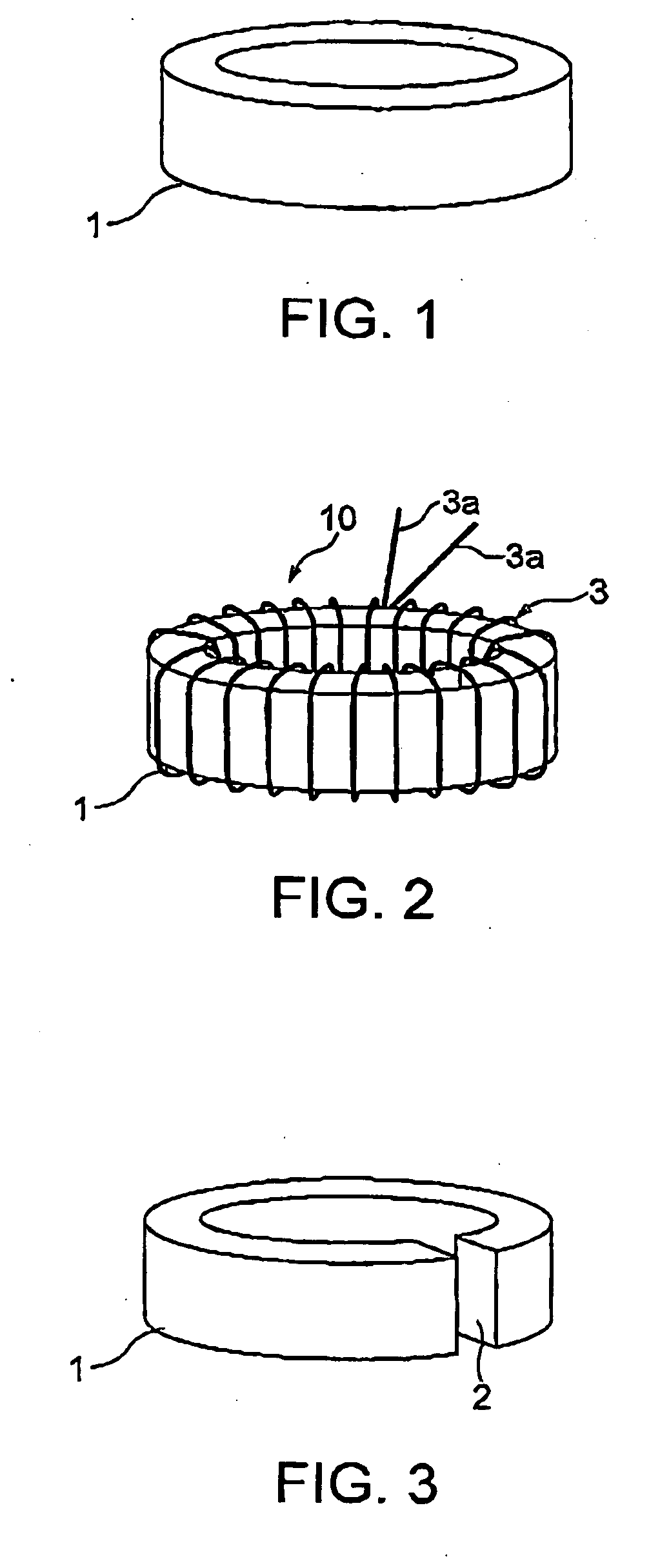Amorphous soft magnetic alloy and inductance component using the same
a soft magnetic alloy and inductance technology, applied in the direction of inductances, magnetic bodies, cores/yokes, etc., can solve the problems of low saturation magnetic flux density, limmiting the application of amorphous alloys, and not yet spread, etc., to achieve excellent amorphous-forming ability, soft magnetic properties, excellent amorphous-forming ability and soft magnetic properties
- Summary
- Abstract
- Description
- Claims
- Application Information
AI Technical Summary
Benefits of technology
Problems solved by technology
Method used
Image
Examples
examples
[0089]Hereinbelow, this invention will be described in detail in terms of Examples.
examples 1 to 15
[0090]Pure metal materials of Fe, P, B, Al, V, Cr, Y, Zr, Nb, Mo, Ta, and W were respectively weighed according to predetermined alloy compositions and then melted by high-frequency heating in a reduced-pressure Ar atmosphere in a chamber after evacuation, thereby producing mother alloys. Thereafter, by the use of the produced mother alloys, ribbons respectively having thicknesses of 20 μm and 200 μm were produced using a single-roll method by adjusting the revolution speed.
[0091]For comparison, a mother alloy having the same composition as that of commercialized METGLAS 2605-S2 was produced by high-frequency heating and then formed into 20 μm and 200 μm ribbons by the single-roll method.
[0092]With respect to each of the 200 μm ribbons, a free solidified surface with the slowest cooling rate, which was not in contact with a copper roll, was measured using the X-ray diffraction method, thereby obtaining an X-ray diffraction profile, and it was judged “amorphous phase” when the obtain...
examples 16 to 24
[0094]Pure metal materials of Fe, P, B, Al, V, Cr, Nb, Mo, Ta, W, and Si were respectively weighed according to predetermined alloy compositions and then melted by high-frequency heating in a reduced-pressure Ar atmosphere in a chamber after evacuation, thereby producing mother alloys. Thereafter, by the use of the produced mother alloys, ribbons respectively having thicknesses of 20 μm and 200 μm were produced by the use of the single-roll method by adjusting the revolution speed.
[0095]With respect to each of the 200 μm ribbons, a free solidified surface with the slowest cooling rate, which was not in contact with a copper roll, was measured by the use of the X-ray diffraction method, thereby obtaining an X-ray diffraction profile, and it was judged “amorphous phase” when the obtained X-ray diffraction profile showed only a broad peak, while it was judged “crystal phase” otherwise. Further, using the 20 μm ribbons, thermal properties were evaluated by DSC. In accordance therewith, ...
PUM
| Property | Measurement | Unit |
|---|---|---|
| ΔTx=Tx-Tg | aaaaa | aaaaa |
| ΔTx=Tx-Tg | aaaaa | aaaaa |
| crystallization start temperature | aaaaa | aaaaa |
Abstract
Description
Claims
Application Information
 Login to View More
Login to View More - R&D
- Intellectual Property
- Life Sciences
- Materials
- Tech Scout
- Unparalleled Data Quality
- Higher Quality Content
- 60% Fewer Hallucinations
Browse by: Latest US Patents, China's latest patents, Technical Efficacy Thesaurus, Application Domain, Technology Topic, Popular Technical Reports.
© 2025 PatSnap. All rights reserved.Legal|Privacy policy|Modern Slavery Act Transparency Statement|Sitemap|About US| Contact US: help@patsnap.com



